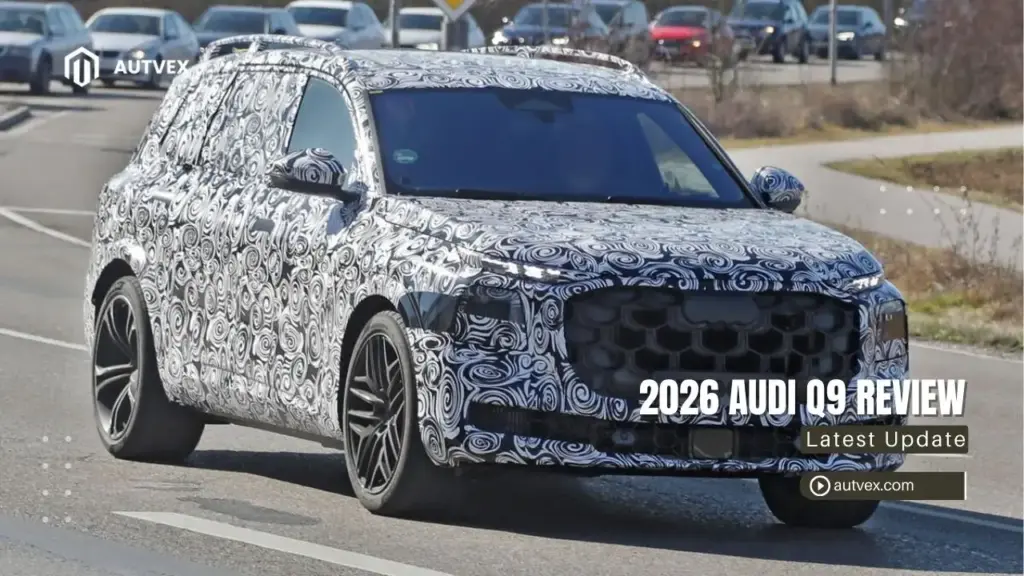Note: The Audi Q9 remains unconfirmed for production. This review is based on spy photos, industry reports, and projected specifications.
The 2026 Audi Q9 has been officially confirmed by Audi development board member Geoffrey Bouquot, marking the German automaker’s long-awaited entry into the full-size three-row luxury SUV segment[1]. Measuring over 5.35 meters (17.5+ feet) in length and seating up to seven passengers, this flagship SUV will launch in 2026 alongside the redesigned Q7, built on the new Premium Platform Combustion (PPC) with gasoline, mild-hybrid, and plug-in hybrid powertrains—not electric[2]. Expected pricing starts around $80,000-$85,000, positioning the Q9 to compete directly against the BMW X7, Mercedes-Benz GLS, Cadillac Escalade, and Lincoln Navigator[3].
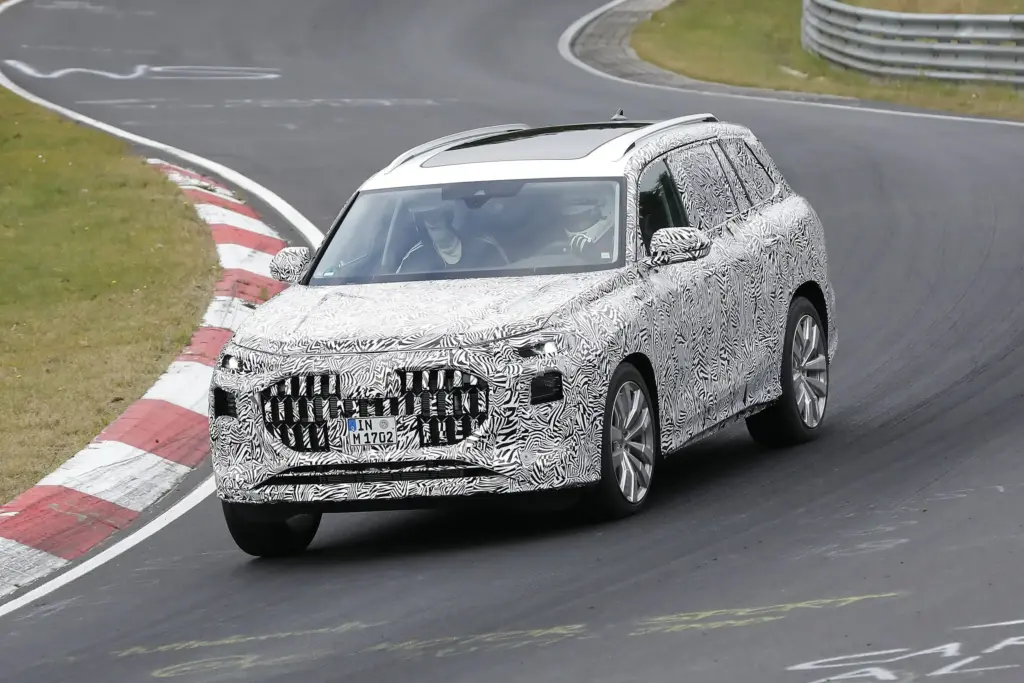
Overview: What Is the 2026 Audi Q9?
Key Specifications at a Glance (Confirmed & Expected)
The 2026 Audi Q9 represents Audi’s largest SUV ever produced, filling a significant gap in the brand’s lineup that left American Audi dealers without a full-size three-row option for years[1]. This flagship positioning targets buyers seeking maximum interior space, adult-friendly third-row seating, and 8,000-pound towing capacity—all wrapped in German luxury engineering[4].
Confirmed & Expected Specifications:
- Size: Over 5.35 meters (17.5+ feet) length, positioning above Q7’s 5.05-meter footprint
- Seating: 6-7 passengers across three rows with optional captain’s chairs
- Launch Timeline: 2026 model year with late 2025 orders, early 2026 deliveries in Europe
- Platform: Premium Platform Combustion (PPC)—combustion-only, not electric
- Direct Competitors: BMW X7, Mercedes-Benz GLS, Cadillac Escalade, Lincoln Navigator
- US Arrival: Mid-to-late 2026, possibly as 2027 model year
According to Autvex automotive experts, the Q9 fills a critical void in Audi’s SUV portfolio that has existed since the brand entered the American luxury market[3]. Understanding what Quattro in Audi means helps appreciate the sophisticated all-wheel-drive system that will underpin this massive flagship.
Official Confirmation and Launch Timeline
In September 2025, Audi development board member Geoffrey Bouquot officially confirmed the Q9’s 2026 launch in an interview with German automotive publication Automobilwoche[1]. This announcement ended years of speculation fueled by spy photographs showing camouflaged prototypes testing across Europe since early 2024.
Official Launch Timeline:
- September 2025: Official confirmation by Audi development leadership
- Late 2025/Early 2026: European market debut and unveiling
- Q4 2025: Order books open in European markets
- Q1 2026: North American pre-orders expected to begin
- Spring 2026: First European customer deliveries
- Summer/Fall 2026: North American arrival (possibly 2027 model year)
The Q9 will launch alongside the completely redesigned third-generation Q7, with both models underpinned by the new Premium Platform Combustion (PPC) architecture[2]. This platform debuts with these models, sharing engineering with future Volkswagen Group products including the next-generation Porsche Cayenne scheduled for 2028.
For buyers considering the purchase timeline, understanding how long it takes to buy a car in the USA helps set realistic expectations—allocate 2-4 hours at dealerships for test drives, financing negotiations, and paperwork completion.
Why Audi Created the Q9
American Audi dealers have specifically requested a full-size three-row SUV for over a decade, watching BMW and Mercedes dominate the segment without competition[1]. The BMW X7 launched in 2018 and the Mercedes-Benz GLS has existed since 2006 (originally as GL-Class), leaving Audi conspicuously absent from this lucrative market segment generating substantial profit margins.
Market Drivers for Q9 Development:
- BMW X7 and Mercedes GLS dominated luxury full-size SUV segment without Audi competition
- American dealers losing sales to German competitors in $80,000-$120,000 SUV range
- Consumer demand for combustion/hybrid alternatives to all-electric models
- Strategic repositioning away from Audi’s aggressive all-EV timeline
- Flagship positioning as “A8 of SUVs” versus Q8 as “A7 of SUVs”
The Q9 also represents Audi’s strategic shift away from its previously aggressive all-EV timeline[5]. Originally, Audi planned to introduce its final combustion engine model in 2026 before going all-electric. However, slower-than-anticipated EV adoption rates in key markets—particularly the United States—forced reconsideration. The Q9’s combustion-powered architecture acknowledges market realities while maintaining Audi’s commitment to electrification through PHEV variants.
Q9 vs Q7 vs Q8: Understanding Audi’s SUV Hierarchy
Audi’s SUV lineup positioning can confuse consumers, with Q7, Q8, and Q9 serving distinct purposes despite numerical proximity. The Q7 serves as the mid-size three-row entry point, the Q8 provides sportback two-row performance focus, and the Q9 will deliver maximum size, luxury, and capability[3].
| Model | Length | Rows | Positioning | Starting Price |
|---|---|---|---|---|
| Q7 | 5.05m (16.6 ft) | 3 rows | Mid-size family SUV | $60,000+ |
| Q8 | 5.00m (16.4 ft) | 2 rows | Performance sportback | $72,000+ |
| Q9 | 5.35m+ (17.5+ ft) | 3 rows | Full-size flagship | $80,000-$85,000 (est.) |
The Q7 targets families prioritizing value and practicality, with cramped third-row seating suitable primarily for children[4]. The Q8 appeals to buyers wanting coupe-SUV styling without third-row seating, emphasizing performance over utility. The Q9 will provide adult-friendly third-row accommodation, maximum cargo capacity, and flagship luxury appointments justifying premium pricing.
For buyers comparing Audi SUV options, exploring best Audi SUV rankings helps identify which model best suits specific needs and budgets. The pricing hierarchy ($60K → $72K → $80K+) reflects capability and luxury escalation across the three models.
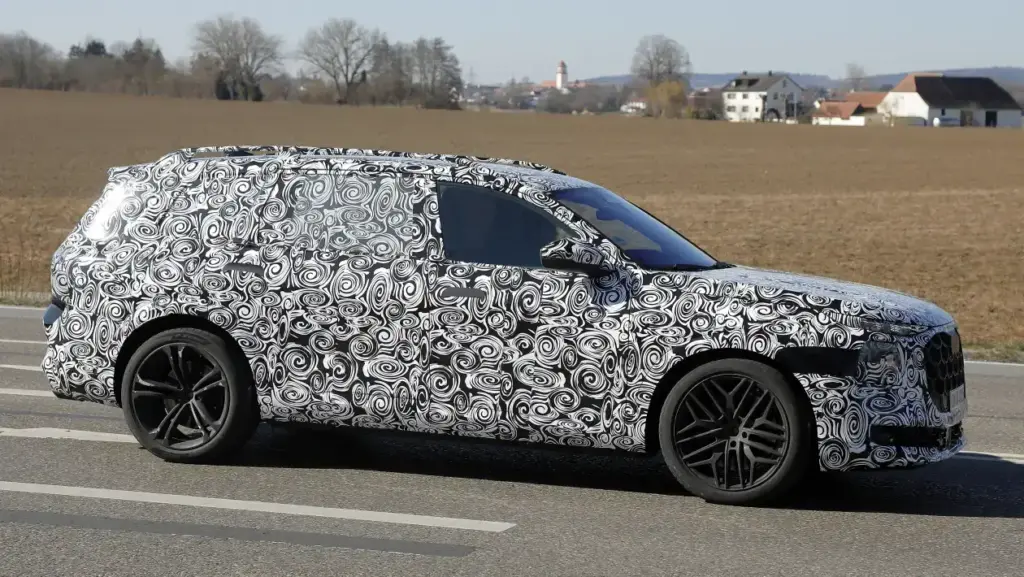
Engine Options & Performance (Expected)
Confirmed Powertrain Architecture
The Premium Platform Combustion (PPC) represents Volkswagen Group’s latest longitudinal-engine architecture, designed from inception to accommodate multiple powertrain types[2]. This flexibility enables Audi to offer gasoline, diesel (Europe only), mild-hybrid, plug-in hybrid, and potential range-extender configurations—all sharing common structural components for manufacturing efficiency.
PPC Platform Capabilities:
- Gasoline engines from 2.0L turbocharged inline-4 to 4.0L twin-turbo V8
- Mild-hybrid 48-volt systems improving fuel economy by 10-15%
- Plug-in hybrid configurations with 50+ mile electric-only range
- Potential range-extender technology (unconfirmed speculation)
- Quattro all-wheel drive standard across entire lineup
- 8-speed automatic transmission expected (possibly new 9-speed)
All Q9 models will feature Quattro all-wheel drive as standard equipment—no front-wheel-drive variants will exist[1]. The 8-speed automatic transmission currently used across Audi’s lineup will likely continue, though rumors suggest a new 9-speed automatic could debut with the Q9 and next-generation Q7.
Base Engine: 45 TFSI (Expected)
The entry-level 45 TFSI variant will likely utilize Audi’s proven 2.0-liter turbocharged inline-four engine paired with 48-volt mild-hybrid technology[3]. This configuration currently powers the Q7 45 TFSI, producing 261 horsepower and 273 lb-ft of torque—expect similar output in the heavier Q9.
45 TFSI Estimated Specifications:
- Engine: 2.0L turbocharged inline-4 + mild-hybrid
- Horsepower: 265 hp (estimated)
- Torque: 273 lb-ft
- 0-60 mph: 6.5-7.0 seconds (estimated)
- Fuel Economy: 22-24 mpg combined (estimated)
- Target Buyers: Price-conscious luxury buyers prioritizing efficiency
The mild-hybrid system utilizes a belt-driven starter-generator and 48-volt battery pack, enabling extended engine-off coasting, seamless start-stop operation, and torque-fill during acceleration[3]. Fuel economy improvements of 10-15% versus non-hybrid configurations make this the efficiency champion of the Q9 lineup.
However, the 2.0L four-cylinder engine will struggle moving the Q9’s estimated 5,500+ pound curb weight with authority. Buyers prioritizing performance should consider the more powerful 55 TFSI or plug-in hybrid variants. Understanding what is MSRP helps buyers negotiate from manufacturer’s suggested pricing baselines when considering different engine options.
Mid-Range Engine: 55 TFSI (Expected)
The 55 TFSI sweet spot balances performance and efficiency using Audi’s respected 3.0-liter turbocharged V6 engine with mild-hybrid technology[3]. This configuration currently delivers 335-340 horsepower in Q7 and Q8 applications—expect similar output for the Q9, potentially with slight power increases to offset additional weight.
55 TFSI Estimated Specifications:
- Engine: 3.0L turbocharged V6 + mild-hybrid
- Horsepower: 340 hp (estimated)
- Torque: 369 lb-ft
- 0-60 mph: 5.5-6.0 seconds (estimated)
- Fuel Economy: 20-22 mpg combined (estimated)
- Target Buyers: Most Q9 buyers seeking balanced performance and refinement
The 3.0L V6 provides smooth, linear power delivery without the harshness sometimes associated with turbocharged four-cylinder engines in heavy applications. The 48-volt mild-hybrid system again improves fuel economy while enhancing low-speed refinement through electric boost during acceleration from stops.
Most Q9 buyers will gravitate toward the 55 TFSI variant, offering adequate performance for highway merging, passing maneuvers, and towing up to 8,000 pounds[4]. The V6’s reputation for reliability and refinement makes it the logical choice for buyers prioritizing long-term ownership satisfaction.
Plug-In Hybrid: 60 TFSIe (Expected)
The 60 TFSIe plug-in hybrid configuration combines a turbocharged four-cylinder engine with an electric motor for combined output approaching 460 horsepower[3]. This powertrain mirrors setups in other Volkswagen Group PHEVs like the Porsche Cayenne E-Hybrid and Bentley Bentayga Hybrid, suggesting proven engineering pedigree.
60 TFSIe PHEV Estimated Specifications:
- Engine: 2.0L turbo-4 + electric motor
- Combined Output: 460 hp (estimated)
- Electric Range: ~50 miles (80 km) EPA estimated
- Total Range: 400+ miles with full tank and battery
- 0-60 mph: 5.0 seconds (estimated)
- Federal Tax Credit: Potential $7,500 (verify IRS.gov eligibility)
The ~50-mile electric-only range enables emissions-free daily commuting for most American drivers, while the gasoline engine provides extended range for road trips without charging anxiety[3]. Total driving range exceeding 400 miles eliminates the range limitations plaguing pure EVs. For buyers considering electric options elsewhere in Audi’s lineup, exploring best Audi electric car options provides perspective on pure-EV alternatives.
The PHEV variant will command a $5,000-$8,000 premium over equivalent gasoline models[3]. However, federal tax credits up to $7,500 (subject to income and MSRP limits) can offset this premium substantially. California and several other states offer additional incentives ranging $2,000-$7,500, making the PHEV financially attractive in certain markets.
Performance Variant: SQ9 (Confirmed)
Audi has confirmed an SQ9 performance variant will launch alongside standard Q9 models, utilizing the venerable 4.0-liter twin-turbocharged V8 engine[2][5]. This powertrain currently produces 500+ horsepower in SQ7 and SQ8 applications—expect similar or slightly higher output in the SQ9.
SQ9 Estimated Specifications:
- Engine: 4.0L twin-turbocharged V8
- Horsepower: 500+ hp (estimated)
- Torque: 550+ lb-ft (estimated)
- 0-60 mph: 4.5 seconds (estimated)
- Top Speed: 155 mph (electronically limited, estimated)
- Pricing: $105,000-$115,000 (estimated)
Sport-tuned Quattro all-wheel drive with rear-biased torque distribution enhances handling agility despite the SQ9’s substantial mass[2]. Adaptive air suspension with sport calibration lowers ride height and stiffens damping rates for improved body control during aggressive driving. Red-painted brake calipers, quad exhaust outlets, and distinctive S-badging differentiate the SQ9 visually from lesser variants.
The SQ9 will compete directly against the BMW X7 M60i ($108,000) and Mercedes-AMG GLS 63 ($135,000+), likely undercutting Mercedes pricing substantially while matching BMW’s performance credentials[5]. For buyers seeking maximum Audi performance, understanding what Audi has the most horsepower provides context on where the SQ9 ranks within the brand’s hierarchy.
Ultra-Performance: RS Q9 (Rumored)
Unconfirmed rumors suggest an ultra-performance RS Q9 variant could arrive 12-18 months after initial launch, though Audi has made no official announcements[5]. If produced, the RS Q9 would likely utilize the 4.0L twin-turbo V8 with hybrid boost, generating approximately 631 horsepower—matching the RS Q8 performance level.
RS Q9 Rumored Specifications:
- Engine: 4.0L twin-turbo V8 + electric motor (rumored)
- Combined Output: 631 hp (estimated, unconfirmed)
- 0-60 mph: Under 4.0 seconds (estimated)
- Pricing: $125,000-$135,000+ (estimated if produced)
- Availability: 2027-2028 at earliest (speculation only)
Track-focused suspension and braking upgrades would accompany the increased power, with carbon-ceramic brakes, upgraded stabilizer bars, and specific RS tuning for adaptive dampers. However, buyers should treat RS Q9 speculation as unconfirmed rumor until Audi makes official announcements.
Towing Capacity and Capability
The Q9’s estimated 8,000-pound towing capacity surpasses both the BMW X7 (7,500 lbs) and Mercedes-Benz GLS (7,700 lbs), positioning it competitively against truck-based American rivals[4]. This capability targets outdoor enthusiasts towing boats, RVs, horse trailers, and other recreational equipment.
Towing & Capability Features:
- Maximum Towing: 8,000 lbs (confirmed expectation)
- Towing Package: Integrated trailer brake controller, heavy-duty cooling
- Safety Systems: Trailer sway control, hill-start assist
- Target Applications: Boats, travel trailers, horse trailers, car haulers
- Comparison: Exceeds X7/GLS, competitive with Escalade (8,200 lbs) and Navigator (8,700 lbs)
Available towing packages will include integrated trailer brake controllers, trailer sway control systems preventing fishtailing during gusty crosswinds, and hill-start assist preventing rollback when launching on steep inclines[4]. For additional perspective on Audi towing capabilities, readers can explore what is the towing capacity of an Audi Q7 to understand how the Q9 compares to its smaller sibling.
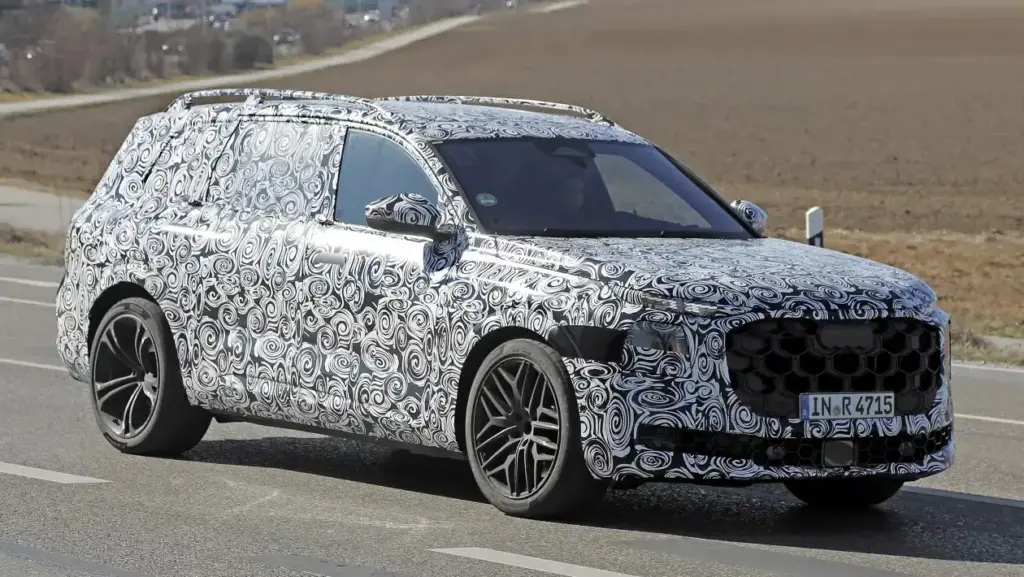
Exterior Design & Styling (Based on Spy Photos)
Front Fascia and Grille Design
Spy photographs reveal the Q9 features Audi’s latest design language with a large octagonal Singleframe grille incorporating honeycomb mesh detailing[6]. The controversial split headlight design—with LED daytime running light strips positioned above main headlamp clusters—follows the pattern established by the Q5, Q6 e-tron, and A6 e-tron.
Front Design Elements:
- Large octagonal Singleframe grille with honeycomb mesh (production-intent design)
- Split headlight design: DRL strip above, main headlamps below
- Similar design language to Q5, Q6 e-tron, A6 e-tron families
- Controversial styling dividing enthusiast opinion
- More refined appearance than BMW X7’s polarizing oversized kidney grilles
The split headlight trend has divided automotive enthusiasts, with some praising the modern, tech-forward appearance while others prefer traditional integrated designs. Spy photos suggest the production Q9 will commit fully to this divisive styling direction, making it a defining characteristic buyers must accept[6].
Compared to the BMW X7’s controversial oversized kidney grilles—which have sparked intense debate since launch—the Q9’s front fascia appears more conservative and traditionally elegant. Mercedes-Benz GLS buyers seeking understated luxury may find the Q9’s styling more appealing than BMW’s bold statement.
Side Profile and Proportions
The Q9’s commanding, muscular stance features an elongated wheelbase providing maximum interior space, particularly for third-row passengers[6]. Spy photographs reveal softer, more rounded design compared to the Q7’s angular proportions—suggesting evolutionary rather than revolutionary styling philosophy.
Side Profile Characteristics:
- Commanding, muscular stance with elongated wheelbase (estimated 3.2m+)
- Softer, more rounded design versus angular Q7
- Sculpted body lines and prominent wheel arches
- Black-painted wheel arch extensions (SQ9 variants)
- Available 21-23 inch multi-spoke alloy wheels
- Sloping roofline more elegant than BMW X7’s boxy shape
Sculpted body lines flow along the doors and quarter panels, creating visual interest without excessive complexity. Prominent wheel arches accommodate massive 21-23 inch multi-spoke alloy wheels—with larger sizes likely reserved for SQ9 and potential RS Q9 variants[2]. Black-painted wheel arch extensions on performance models add visual aggression while protecting painted surfaces from rock chips.
The sloping roofline provides more elegance than the BMW X7’s utilitarian boxy shape, though it may sacrifice minor headroom in the third row compared to more upright competitors[6]. This design compromise prioritizes aesthetics over maximum space—a characteristic German luxury philosophy.
Rear Design Elements
Full-width OLED taillight bars with customizable light signatures will dominate the Q9’s rear styling, following the pattern established across Audi’s latest models[6]. Bulges above the rear wheels flow seamlessly into taillight clusters, creating visual width and planted stance. An integrated rear spoiler provides aerodynamic efficiency while enhancing the performance-oriented appearance.
Rear Design Features:
- Full-width OLED taillight bar with customizable signatures
- Bulges above rear wheels flowing into taillight clusters
- Integrated rear spoiler for aerodynamic efficiency
- Dual exhaust outlets (standard models)
- Quad exhaust outlets (SQ9/RS Q9 variants)
- Power liftgate with hands-free operation expected
Dual exhaust outlets will characterize standard Q9 models, while SQ9 and potential RS Q9 variants feature quad outlets signaling performance credentials. The power liftgate with hands-free operation—activated by foot motion under the rear bumper—provides convenience when hands are full with groceries or luggage[3].
Exterior Color Options (Expected)
While Audi hasn’t officially announced the Q9 color palette, expect traditional Audi colors alongside exclusive S-line and SQ9 offerings. Premium metallic and pearl effect finishes will command $500-$1,500 premiums over standard solid colors[3].
Expected Color Categories:
- Traditional Audi colors (Mythos Black, Glacier White, Daytona Grey)
- Exclusive S-line/SQ9 colors (unique metallic and pearl finishes)
- Black Optic styling package (blacked-out trim and badges)
- Contrast roof color options (potentially)
- Custom Audi Exclusive colors ($3,000-$10,000+ premium)
The Black Optic styling package will likely be available across the lineup, replacing chrome exterior trim with gloss black finishes for a more aggressive, contemporary appearance. Contrast roof colors—where the roof is painted differently from the body—remain unconfirmed but could differentiate the Q9 from competitors.
Design Comparisons: Q9 vs Competitors
Spy photographs suggest the Q9 adopts more elegant, refined styling than the BMW X7’s controversial design[6]. While the X7’s massive kidney grilles have divided opinion since launch, the Q9 appears more conservative and traditionally luxurious. Mercedes-Benz GLS maintains the most understated, conservative approach—the Q9 falls between these extremes.
Design Philosophy Comparison:
- Q9: Modern, tech-forward but not polarizing; split headlights controversial element
- BMW X7: Bold, statement-making with divisive oversized kidney grilles
- Mercedes GLS: Conservative, understated traditional luxury approach
- Escalade/Navigator: Truck-like, commanding American luxury aesthetic
- Verdict: Personal preference determines winner; Q9 less polarizing than X7
The Q9’s design appears less truck-like than the Cadillac Escalade and Lincoln Navigator, which embrace bold American luxury aesthetics with vertical lighting signatures and upright proportions[6]. Distinctly Audi design language with modern touches creates cohesive brand identity across the expanding Q-series lineup.
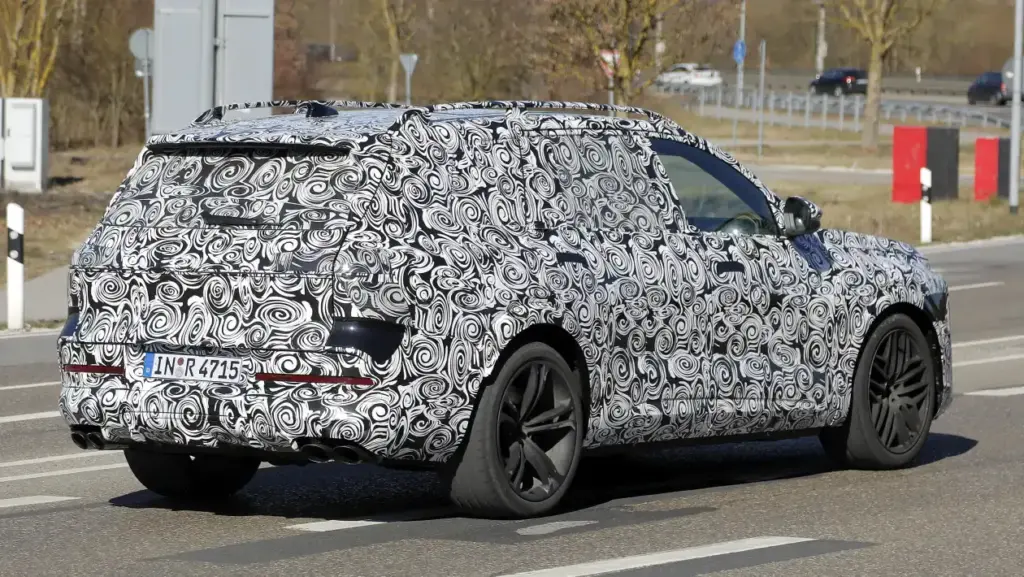
Interior Design, Technology & Features (Expected)
Cabin Layout and Seating Configurations
The Q9’s three-row layout will accommodate 6 or 7 passengers depending on second-row configuration—captain’s chairs for six-passenger luxury or bench seating for seven-passenger capacity[3]. Generous legroom across all three rows represents a key improvement over the Q7’s cramped third-row accommodations, which suit children better than adults.
Seating Configurations:
- Six-passenger: Second-row captain’s chairs with center console passage to third row
- Seven-passenger: Second-row bench seat (60/40 split folding)
- First Row: Heated and ventilated with massage function, power adjustment
- Second Row: Generous legroom, reclining seatbacks, climate controls
- Third Row: Adult-friendly space (key improvement over Q7), power-folding operation
Premium materials including soft-touch surfaces, plush leather upholstery, and aluminum or wood trim accents will characterize the cabin’s fit and finish[3]. Heated and ventilated front seats come standard, with massaging functions available—luxury amenities expected at this price point.
The Q9 will target BMW X7 and Mercedes GLS third-row space and comfort, addressing the Q7’s most significant weakness[4]. Adult passengers should fit comfortably for extended journeys—a critical requirement for a $80,000+ three-row SUV. For buyers evaluating what car has the best air conditioning for the back seat, the Q9’s four-zone climate control ensures all passengers maintain individual comfort preferences.
Third-Row Space and Usability
Adult-friendly third-row seating represents the Q9’s most critical interior requirement—this single feature will determine its competitiveness against established rivals offering genuine three-row utility[4]. Power-folding third-row seats with one-touch operation provide convenience, while improved headroom and legroom versus the current Q7 address longstanding complaints.
Third-Row Features:
- Adult-friendly dimensions (competitive with BMW X7, Mercedes GLS)
- Power-folding operation with one-touch buttons
- Improved headroom and legroom versus Q7
- Dedicated climate controls and USB charging ports
- Cupholders and storage compartments
Third-row climate controls and USB charging ports ensure rear passengers don’t feel like afterthoughts—critical for long road trips with full vehicle capacity. Cupholders and small-item storage compartments add convenience missing from many cramped third-row implementations prioritizing space over amenities.
Cargo Space and Versatility
Cavernous cargo area with all three rows occupied will exceed Q7 capacity, though exact cubic-foot measurements remain unannounced. Power-folding second and third rows enable maximum cargo capacity approaching 85+ cubic feet with seats folded[3]—competitive with segment leaders.
Cargo Features:
- Cavernous area with all seats raised (estimated 20-25 cu ft)
- Power-folding second/third rows for maximum capacity
- Estimated total cargo: 85+ cubic feet (seats folded)
- Underfloor storage compartments for valuables
- Power liftgate with programmable height memory
Underfloor storage compartments provide secure space for valuables, tools, or emergency equipment without consuming main cargo area. Power liftgate with programmable height memory prevents overhead clearance issues in low garages—a thoughtful convenience feature[3].
Digital Cockpit and Infotainment
Audi’s “Digital Stage” curved display layout will debut in the Q9, integrating multiple high-resolution screens into a seamless driver-focused interface[3]. The dual-screen MMI infotainment system features a 14.5-inch center display for navigation, audio, and vehicle settings, while the Audi Virtual Cockpit digital instrument cluster spans 11.9-12.3 inches displaying speed, navigation, and driver assistance information.
Digital Cockpit Components:
- Center Display: 14.5-inch MMI touchscreen (navigation, audio, vehicle settings)
- Instrument Cluster: 11.9-12.3 inch Audi Virtual Cockpit
- Passenger Display: Optional 10.9-inch screen (entertainment, navigation viewing)
- Operating System: Android Automotive OS with Google built-in
- Smartphone Integration: Wireless Apple CarPlay and Android Auto
- Voice Assistant: ChatGPT-powered AI for natural language commands
The optional 10.9-inch front passenger display screen enables front passengers to browse navigation, adjust entertainment, or access vehicle information without distracting the driver[3]. Android Automotive OS with Google built-in provides access to Google Maps (superior to Audi’s proprietary navigation), Google Assistant voice control, and the Google Play Store for third-party app downloads.
ChatGPT-powered AI voice assistant integration enables natural language commands—ask “Where’s the nearest Electrify America charging station?” and the system understands context without rigid voice command structures[3]. While less mature than Tesla’s voice assistant, Audi’s system continues improving through over-the-air updates. Buyers wondering does Audi charge for Apple CarPlay will find wireless integration included as standard—no subscription fees required.
Premium Audio and Comfort Features
Bang & Olufsen Premium 3D Sound System will be available across the Q9 lineup, featuring 20+ speakers and 800+ watts of amplification delivering concert-hall audio quality[3]. This system surpasses BMW and Mercedes base audio configurations according to professional reviewers, providing genuine audiophile-grade performance justifying the $3,000-$5,000 premium.
Comfort & Convenience Features:
- Audio: Bang & Olufsen Premium 3D Sound (available, 20+ speakers, 800+ watts)
- Sunroof: Panoramic power sunroof (standard or available)
- Lighting: Ambient interior lighting with customizable colors (30+ options)
- Climate: Four-zone automatic climate control with individual settings
- Cupholders: Heated and cooled cupholders (Prestige trim)
- Seats: Massaging front seats (available on Premium Plus and above)
Panoramic power sunroof will likely be standard on higher trims and available on base models, flooding the cabin with natural light while maintaining headroom. Ambient interior lighting with 30+ customizable colors allows personalization matching mood or preference—a feature that sounds gimmicky but proves surprisingly enjoyable in practice[3].
Heated and cooled cupholders—available on Prestige trim—maintain beverage temperatures during extended journeys. While seemingly frivolous, this feature proves genuinely useful for keeping morning coffee hot or afternoon iced tea cold throughout multi-hour road trips.
Technology and Connectivity
Audi Connect services with remote vehicle monitoring enable pre-conditioning, remote start, and vehicle location tracking through the myAudi smartphone app[3]. Over-the-air software update capability ensures the Q9 improves throughout ownership, with bug fixes, feature additions, and performance optimizations delivered wirelessly without dealer visits.
Connectivity Features:
- Remote Services: Audi Connect with myAudi app (pre-conditioning, remote start, location tracking)
- Updates: Over-the-air software capability for continuous improvement
- Wi-Fi: 4G/5G hotspot with data subscription
- USB Ports: Multiple USB-C charging ports throughout all three rows
- Wireless Charging: Smartphone charging pad (front console)
Wi-Fi hotspot with 4G/5G connectivity requires data subscription (typically $20-$30/month after complimentary trial period) but provides reliable internet access for passengers[3]. Multiple USB-C charging ports throughout all three rows ensure every passenger can charge devices simultaneously—critical for modern families with tablets, phones, and portable gaming systems.
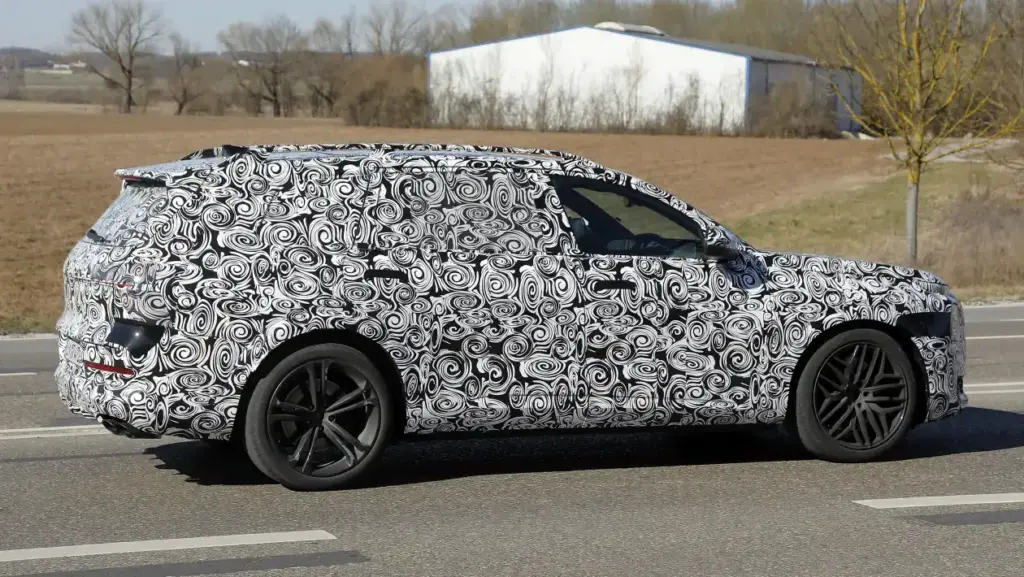
Safety Features & Driver Assistance (Expected)
Standard Safety Technologies
Comprehensive passive and active safety equipment will come standard across all Q9 trims, meeting increasingly stringent US federal safety regulations. Automated emergency braking with pedestrian detection monitors forward traffic continuously, applying brakes automatically when collision risks materialize and driver response proves insufficient[3].
Standard Safety Equipment:
- Automated emergency braking with pedestrian/cyclist detection
- Lane departure warning with Active Lane Assist (gentle steering correction)
- Blind-spot monitoring with rear cross-traffic alert
- Driver drowsiness detection analyzing steering patterns
- Road sign recognition displaying limits in instrument cluster
- Front and rear parking sensors with audible/visual guidance
- Rearview camera with dynamic guidelines
Lane departure warning with Active Lane Assist gently steers the vehicle back toward lane center when unintended drift occurs without turn signal activation. Blind-spot monitoring with rear cross-traffic alert prevents lane-change collisions and warns of approaching traffic when reversing from parking spaces[3].
Driver drowsiness detection analyzes steering patterns, driving duration, and time of day—recommending rest breaks when fatigue indicators appear. Road sign recognition displays speed limits and other regulatory signs within the instrument cluster, ensuring drivers maintain awareness of changing restrictions.
Available Advanced Driver Aids
Premium Plus and Prestige trims gain adaptive cruise control with stop-and-go capability, providing semi-automated highway driving that maintains set speeds, adjusts following distance automatically, and handles stop-and-go traffic without driver input[3]. Lane-centering steering assist keeps the vehicle centered within lane markings during gentle curves, reducing steering effort during extended highway journeys.
Advanced Driver Assistance (Available):
- Adaptive cruise control with stop-and-go (Premium Plus+)
- Lane-centering steering assist for semi-automated highway driving
- Traffic jam assist handling acceleration, braking, steering below 40 mph
- 360-degree surround-view camera system (Premium Plus+)
- HD head-up display with augmented reality navigation (Prestige)
- Four-wheel steering improving maneuverability (available)
- Park assist plus with semi-automated parking (Prestige)
Traffic jam assist provides low-speed automation during congested conditions, handling steering, acceleration, and braking inputs below approximately 40 mph. The system reduces stress during stop-and-go traffic, though drivers must maintain attention and readiness to resume control at any moment—this is not full autonomous driving[3].
The 360-degree surround-view camera system compiles feeds from multiple cameras into a virtual overhead view, simplifying parking in tight spaces. HD head-up display with augmented reality navigation (Prestige only) projects navigation arrows directly onto the road ahead, improving situational awareness without requiring glances away from traffic.
Four-wheel steering—where rear wheels turn opposite or same direction as fronts depending on speed—improves low-speed maneuverability and high-speed stability[3]. This technology proves particularly valuable given the Q9’s substantial 17.5+ foot length, making parking lot navigation more manageable.
Safety Ratings and Crash Testing
Euro NCAP and IIHS crash testing will occur post-launch, with results expected 6-12 months after first deliveries[3]. The PPC platform was engineered from inception for maximum crash protection, with crumple zones, reinforced passenger compartment, and advanced high-strength steel body structure providing occupant safety.
Safety Structure:
- Euro NCAP and IIHS testing expected post-launch (pending)
- PPC platform engineered for maximum crash protection
- Multiple airbags including curtain airbags protecting all three rows
- Advanced high-strength steel body structure
- Pedestrian protection systems (active hood, energy-absorbing bumpers)
Multiple airbags including side-curtain airbags protecting all three rows will come standard. Pedestrian protection systems including active hood mechanisms and energy-absorbing bumpers help protect vulnerable road users during collisions—increasingly important as safety regulations expand beyond occupant protection.
Warranty and Maintenance Coverage (Expected)
Audi’s 4-year/50,000-mile limited warranty will likely continue for the Q9, matching current brand coverage[3]. The powertrain warranty spans the same 4-year/50,000-mile period—unusual given many manufacturers provide longer powertrain coverage. A 12-year unlimited-mile corrosion perforation warranty protects against rust-through of body panels.
Expected Warranty Coverage:
- 4-year/50,000-mile limited vehicle warranty
- 4-year/50,000-mile powertrain warranty (same as limited)
- 12-year unlimited-mile corrosion perforation warranty
- Possible Audi Signature Care complimentary maintenance program
- Roadside assistance for warranty period
The new Audi Signature Care complimentary maintenance program may extend to the Q9, offering scheduled maintenance coverage for the warranty period[3]. This would add significant value, potentially saving $1,000-$2,000 in maintenance costs over four years. Roadside assistance for the warranty period provides towing, flat tire changes, and lockout services—standard features across the luxury segment.
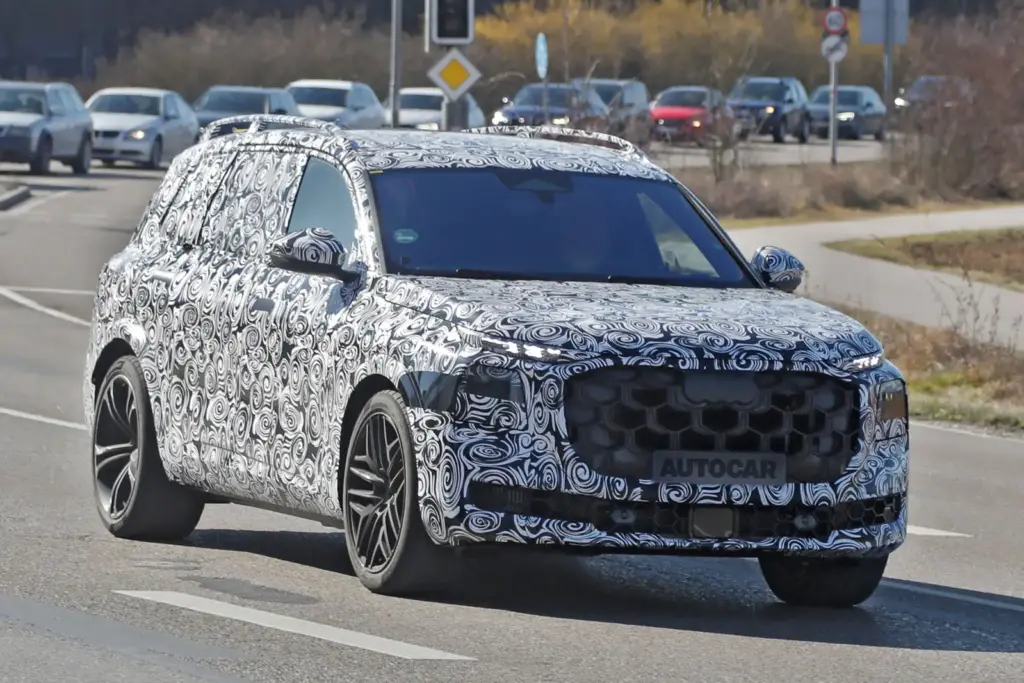
Pricing & Trim Levels (Projected)
Expected Starting Price: $80,000-$85,000
The base Q9 45 TFSI Premium trim is expected to start around $80,000-$82,000, positioning it competitively against the BMW X7 ($84,000+ xDrive40i) and Mercedes-Benz GLS ($82,000+ GLS 450)[3][4]. This pricing undercuts the Cadillac Escalade ($87,000+) and matches the Lincoln Navigator ($82,000+), providing German engineering at competitive American luxury pricing.
| Trim Level | Expected Starting Price | Target Competitors |
|---|---|---|
| Premium (45 TFSI) | $80,000-$82,000 | BMW X7 xDrive40i, Mercedes GLS 450 |
| Premium Plus (55 TFSI) | $90,000-$95,000 | BMW X7 M50i, Mercedes GLS 580 |
| Prestige (55 TFSI) | $95,000-$100,000 | Top-tier X7/GLS configurations |
| PHEV Variants | +$5,000-$8,000 | Unique offering (no X7/GLS PHEV exists) |
| SQ9 (V8) | $105,000-$115,000 | BMW X7 M60i ($108,000), Mercedes-AMG GLS 63 ($135,000) |
The Q9’s premium positioning reflects flagship status as Audi’s largest, most luxurious SUV. Positioned above the Q7 ($60,000+) and Q8 ($72,000+), the Q9 justifies pricing through increased size, third-row adult accommodation, and flagship luxury appointments[3].
According to Autvex market analysis, the Q9’s competitive pricing versus BMW and Mercedes provides meaningful value advantage—particularly when considering standard equipment levels[4]. The Q9 is expected to include more features as standard compared to German rivals requiring expensive option packages.
Mid-Tier Trims: Premium Plus and Prestige
Premium Plus trim expected around $90,000-$95,000 adds substantial technology and luxury equipment[3]. Key additions include adaptive cruise control with lane-centering, Bang & Olufsen premium audio, heated rear seats, LED interior lighting packages, and 360-degree camera systems. The Premium Plus represents the sweet spot for most Q9 buyers, balancing luxury features with reasonable pricing.
Premium Plus Expected Features:
- Adaptive cruise control with stop-and-go and lane-centering
- Bang & Olufsen Premium 3D Sound System
- Heated rear seats with climate controls
- LED interior ambient lighting plus package
- 360-degree surround-view camera system
- HD head-up display (may be Prestige-only)
- Upgraded wheel options (22-inch)
Prestige trim approaching $95,000-$100,000 targets buyers seeking maximum luxury and technology[3]. Exclusive features include HD head-up display with augmented reality navigation, park assist plus with semi-automated parking, front passenger display screen, power rear window shades, and unique interior trim options.
PHEV variants command $5,000-$8,000 premiums over equivalent gasoline models[3]. However, federal tax credits up to $7,500 (subject to verification) can offset this premium substantially. Combined with state incentives in California ($2,000-$7,500 additional) and other EV-friendly states, the PHEV may actually cost less than gasoline equivalents after incentives.
Black Optic and S-line appearance packages will be available across the lineup, replacing chrome trim with gloss black finishes and adding sport-inspired styling elements. Technology packages with enhanced driver aids provide additional customization options for buyers prioritizing specific features.
Performance Models: SQ9 and RS Q9 Pricing
The SQ9 is expected to start around $105,000-$115,000, competing directly against the BMW X7 M60i ($108,000) and significantly undercutting the Mercedes-AMG GLS 63 ($135,000+)[5]. Exclusive exterior colors including unique metallic and pearl finishes, premium interior appointments with carbon fiber and Alcantara accents, and performance-oriented standard equipment justify the substantial premium over standard Q9 models.
SQ9 Expected Pricing & Features:
- Starting Price: $105,000-$115,000 (estimated)
- Exclusive Colors: Unique S-model metallic and pearl finishes
- Interior: Carbon fiber, Alcantara, sport seats with aggressive bolstering
- Performance: 4.0L twin-turbo V8 (~500+ hp), sport exhaust, upgraded brakes
- Wheels: 22-23 inch exclusive designs with performance tires
The potential RS Q9—if produced—would exceed $125,000-$135,000+, positioning it against the Mercedes-AMG GLS 63’s $135,000+ pricing[5]. However, this variant remains pure speculation until Audi makes official announcements. Buyers should not assume RS Q9 production is guaranteed.
Value Proposition: Q9 vs Competitors
The Q9’s expected pricing advantage of $2,000-$5,000 versus BMW X7 and Mercedes GLS provides meaningful value[3][4]. More standard equipment than German competitors—with features like quattro AWD, adaptive air suspension, and digital cockpit included rather than optional—enhances value perception further.
Q9 Value Advantages:
- $2,000-$5,000 lower starting price vs X7/GLS
- More standard equipment (quattro AWD, adaptive air suspension, digital cockpit)
- Plug-in hybrid availability (no X7 or GLS PHEV exists)
- Better technology integration than truck-based American rivals (Escalade/Navigator)
- Strong residual values expected (Audi Q-series historical track record)
The plug-in hybrid option represents a unique offering unavailable in the BMW X7 or Mercedes GLS lineups[3]. Buyers seeking reduced emissions, potential federal tax credits, and electric-only commuting capability find no comparable options from German competitors—only the Q9 PHEV satisfies these requirements.
Better technology integration than truck-based American rivals (Escalade/Navigator) appeals to tech-forward buyers prioritizing modern infotainment and driver assistance. While the Escalade and Navigator offer commanding presence and maximum interior space, the Q9 provides more refined on-road dynamics and advanced technology.

Key Takeaways
- The 2026 Audi Q9 is officially confirmed for 2026 launch, measuring over 17.5 feet with adult-friendly three-row seating for 6-7 passengers[1][2].
- Expected pricing starts $80,000-$85,000 for base Premium trim, undercutting BMW X7 and Mercedes GLS while exceeding Q7/Q8[3].
- Multiple powertrains expected: 2.0L turbo-4, 3.0L turbo V6, plug-in hybrid (~460 hp, 50-mile EV range), and confirmed SQ9 V8[2][3][5].
- Platform is Premium Platform Combustion (PPC)—gasoline/hybrid only, not electric, representing Audi’s strategic shift from aggressive EV timeline[2][5].
- Towing capacity expected at 8,000 pounds, exceeding BMW X7 (7,500 lbs) and Mercedes GLS (7,700 lbs)[4].
- European debut late 2025/early 2026; North American arrival mid-to-late 2026, possibly as 2027 model year[1].
- Wait for Q9 if seeking Audi’s newest flagship technology; buy BMW X7 or Mercedes GLS now if needing vehicle immediately[1].
Frequently Asked Questions
When will the 2026 Audi Q9 be released?
European market debut is expected late 2025 or early 2026, with order books opening in Q4 2025[1]. North American arrival will follow in mid-to-late 2026, possibly as a 2027 model year vehicle. First European customer deliveries should begin spring 2026, while US deliveries likely start summer/fall 2026.
How much will the 2026 Audi Q9 cost?
Base Premium trim pricing is projected at $80,000-$85,000, mid-tier Prestige around $95,000-$100,000, and performance SQ9 approximately $105,000-$115,000[3]. These estimates position the Q9 competitively against BMW X7 ($84,000+) and Mercedes GLS ($82,000+), while undercutting Cadillac Escalade ($87,000+).
What engines will the 2026 Audi Q9 have?
Expected powertrains include: 2.0L turbocharged inline-4 with mild-hybrid (~265 hp), 3.0L turbocharged V6 with mild-hybrid (~340 hp), plug-in hybrid combining turbo-4 and electric motor (~460 hp with 50-mile EV range), confirmed SQ9 with 4.0L twin-turbo V8 (~500+ hp), and rumored RS Q9 with V8 hybrid (~631 hp)[2][3][5].
How does the Q9 compare to BMW X7 and Mercedes GLS?
Q9 advantages include lower starting price ($80K-$85K vs $82K-$84K+), plug-in hybrid availability (no X7/GLS PHEV exists), newer technology integration, and higher towing capacity (8,000 vs 7,500-7,700 lbs)[3][4]. X7/GLS advantages include immediate availability, proven reliability track records, and established brand reputations. Size, luxury, and performance prove competitive across all three.
Will the 2026 Audi Q9 be electric?
No—the Q9 uses the Premium Platform Combustion (PPC), offering gasoline, mild-hybrid, and plug-in hybrid powertrains[2][5]. This represents Audi’s strategic shift away from its aggressive all-EV timeline in response to slower-than-anticipated electric vehicle adoption rates. An electric full-size SUV may arrive later as a separate model. The PHEV variant offers approximately 50 miles of electric-only driving.
How many passengers does the Q9 seat?
The Q9 features three-row configuration seating 6 or 7 passengers[3]. Six-passenger layout includes second-row captain’s chairs with center console passage to the third row. Seven-passenger layout features a second-row bench seat with 60/40 split folding. Adult-friendly third-row space represents a key improvement over the Q7’s cramped rear accommodations. All three rows include climate controls and USB charging ports.
What is the towing capacity of the 2026 Audi Q9?
Expected towing capacity is 8,000 pounds, exceeding the BMW X7 (7,500 lbs) and Mercedes-Benz GLS (7,700 lbs)[4]. This capacity proves competitive with truck-based American rivals like the Cadillac Escalade (8,200 lbs) and Lincoln Navigator (8,700 lbs). An integrated trailer brake controller will be available, along with trailer sway control and hill-start assist systems. The Q9 suits buyers towing boats, travel trailers, horse trailers, and recreational equipment.
Should I wait for the Q9 or buy a Q7 or Q8 now?
Wait for the Q9 if needing true full-size space, adult-friendly third-row seating, maximum luxury appointments, and latest technology—can delay purchase until late 2026[1]. Buy the Q7 now if needing a vehicle immediately, preferring smaller/more manageable size, and wanting lower pricing ($60,000+). Buy the Q8 now if wanting sportback styling, not requiring third-row seating, and prioritizing performance over utility. The Q9 will be Audi’s largest, most luxurious SUV ever produced.
References
- Car and Driver. (2025). Audi Reportedly Plans to Launch a Full-Size 3-Row SUV Known as the Q9 in 2026. https://www.caranddriver.com/news/a68118738/audi-q9-three-row-suv-launch-date-report/
- Carsales Australia. (2025). Huge Audi Q9 SUV to launch next year. https://www.carsales.com.au/editorial/details/huge-audi-q9-suv-to-launch-next-year-150482/
- Audi Anjou. (2025). 2026 Audi Q9: Price and What We Know. https://www.audianjou.com/blog/2025/august/20/audi-q9-price-specs.htm
- Road and Track. (2025). Audi Q9 3-Row SUV Arrives in 2026 to Battle BMW X7 and Mercedes GLS. https://www.roadandtrack.com/news/a68112718/audi-q9-suv-arrives-2026-exec-says/
- AutoEvolution. (2025). Audi Confirms the Q9 – What We Know So Far and Why Cadillac Escalade Should Pay Attention. https://www.autoevolution.com/news/audi-confirmed-the-q9-what-we-know-so-far-and-cadillac-escalade-should-pay-attention-258123.html
- Carsales Australia. (2022). Audi Q9 flagship SUV coming soon. https://www.carsales.com.au/editorial/details/audi-q9-flagship-suv-coming-soon-136671/

I am a senior automotive analyst at Autvex. Expert vehicle evaluations, in-depth reviews, and objective analysis helping readers make informed automotive decisions with years of industry experience.

